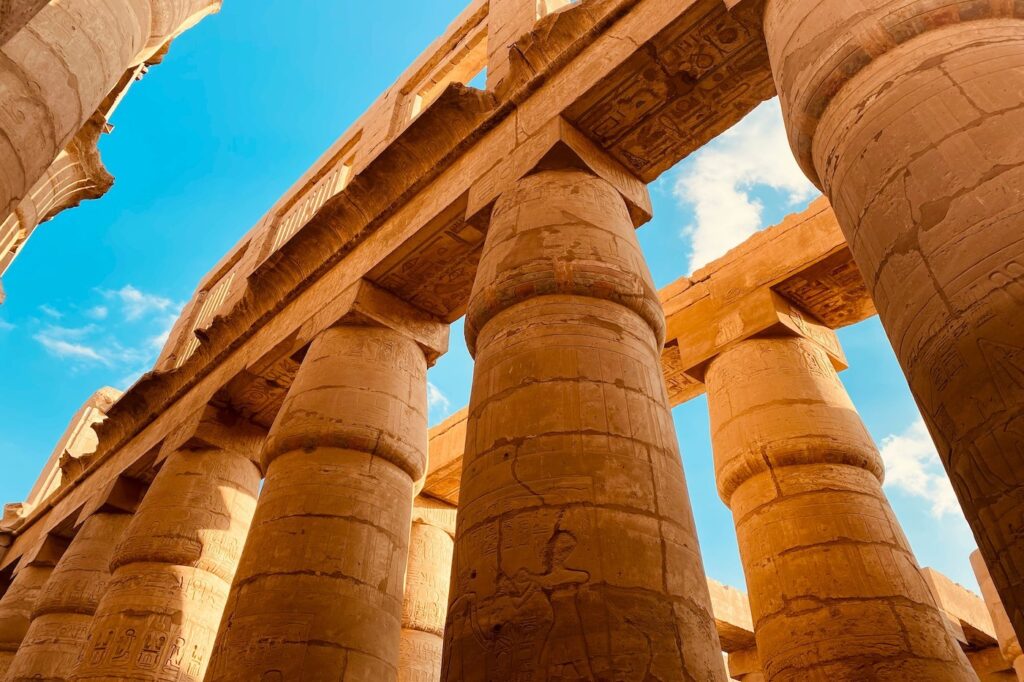Karnak Temple, situated near Luxor in Egypt, is one of the most magnificent architectural achievements of the ancient world. This vast complex of temples, chapels, and sanctuaries was built over nearly two millennia, reflecting the dedication of numerous pharaohs who contributed to its construction. Its enormous columns, elaborate carvings, and massive gateways speak volumes about the skill and devotion of its creators.
Serving as a focal point for religious life during the height of ancient Egypt, Karnak Temple remains a testament to the ingenuity and cultural significance of its builders. It is a masterpiece of human achievement, steeped in history and filled with mysteries waiting to be unraveled. Visitors to this incredible site are drawn into a world of ancient rituals, architectural brilliance, and stories etched in stone.
The grandeur of the temple’s construction
Karnak Temple was not built by a single ruler or even during a single period. Instead, it represents the collective effort of generations of kings and craftsmen.
The temple’s centerpiece, the Great Hypostyle Hall, is a vast space filled with 134 towering columns, each carved with intricate symbols and inscriptions. These columns, arranged in 16 rows, create a forest of stone that inspires awe in anyone who stands among them. The hall was begun under the reign of Seti I and expanded by Ramses II, reflecting the evolving artistic styles of the New Kingdom era.
In addition to the main sanctuary dedicated to Amun, Karnak Temple features smaller shrines honoring other deities. This arrangement underscores the temple’s role as a center of worship, where rituals were performed to honor multiple gods. The construction also included large pylons—monumental gateways that marked the transition from one sacred space to another. Each pylon was added by a different ruler, contributing to the layered history of the site.
The process of building the temple required immense resources, including quarries to supply stone, skilled artisans to carve the intricate designs, and laborers to transport and assemble the materials. This monumental effort reflects the importance of the temple as both a religious and political symbol.
Artistic mastery etched in stone
The walls and columns of Karnak Temple are adorned with carvings and inscriptions that convey both religious and historical narratives. These artworks serve as a visual record of ancient Egyptian beliefs and the achievements of its rulers.
One of the most striking aspects of the carvings is their depiction of royal ceremonies. Pharaohs are shown making offerings to the gods, reaffirming their divine authority and the close relationship between the rulers and the deities they served. These scenes often include details about the offerings, such as food, incense, and precious materials.

Another prominent feature is the hieroglyphic writing that covers much of the temple’s surface. These inscriptions include prayers, hymns, and records of significant events. For example, some texts recount military victories, showcasing the pharaohs as both spiritual leaders and protectors of their people.
The temple’s artwork also includes depictions of daily life and nature, providing a glimpse into the culture and environment of ancient Egypt. The detailed representations of animals, plants, and people highlight the skill and creativity of the artists who worked on the site.
The religious significance of Karnak
Karnak Temple was a central hub for worship in ancient Egypt, dedicated primarily to the god Amun. It served as the spiritual heart of the Theban region and a key location for religious ceremonies.
During annual festivals, priests would carry the statue of Amun from the temple in a sacred boat, traveling along processional routes lined with sphinxes. These ceremonies reinforced the connection between the temple, the gods, and the community it served. The temple was not only a place of worship but also a stage for displays of royal power and divine favor.
In addition to its role as a religious center, Karnak Temple held an important position in the political landscape of ancient Egypt. The pharaohs used the site to legitimize their authority, often commissioning additions or renovations to demonstrate their devotion and leave a lasting legacy. These contributions were a way of ensuring that their names and achievements would be remembered for generations.
The temple’s vast scale and intricate design reflect its importance as a sacred space. Each structure within the complex was carefully planned and executed to create an environment that honored the gods and inspired reverence in those who visited.
The enduring legacy of Karnak
Karnak Temple remains a symbol of ancient Egypt’s cultural and architectural achievements. Despite the passage of millennia, it continues to draw visitors who are captivated by its grandeur and historical significance.
Modern archaeological efforts have helped to uncover more about the temple’s history, revealing details about its construction, use, and the people who built it. These discoveries provide valuable insights into the beliefs and practices of ancient Egyptian society.
The preservation of Karnak Temple is an ongoing challenge, as exposure to the elements and the impact of tourism take their toll. Conservation efforts aim to protect the site while ensuring that future generations can experience its beauty and significance.
For those who visit, Karnak Temple offers an opportunity to connect with the past and marvel at the ingenuity of its creators. It stands as a testament to human achievement and the enduring power of art, faith, and imagination.


